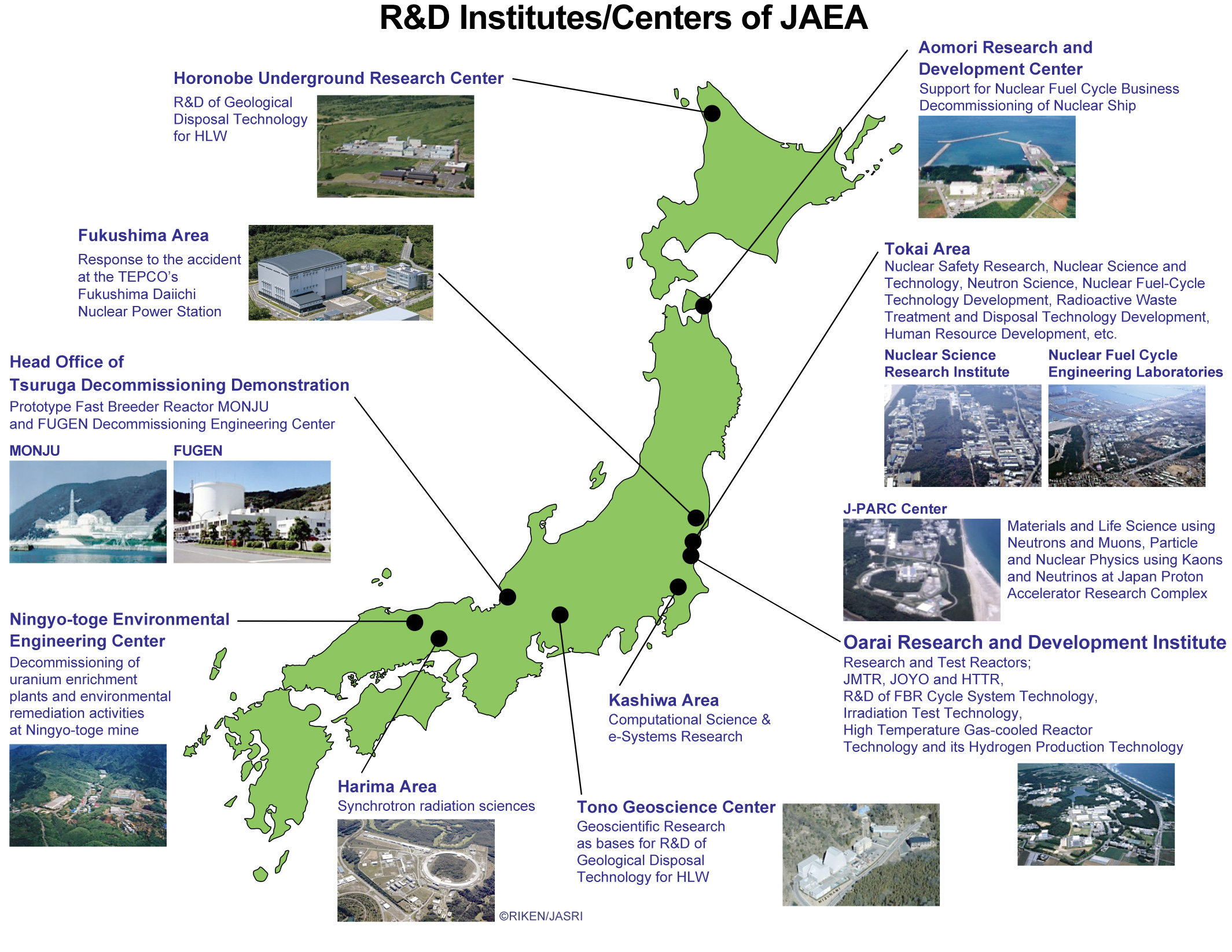This publication introduces our latest research and development (R&D) results in each field. Each chapter presents the activities of one R&D Sector. The various R&D Sectors perform their activities through R&D centers or institutes. Depending on the R&D activities, some of these centers or institutes comprise only one site, whereas others comprise two or more sites. The R&D centers and institutes are located throughout Japan, as shown on the map below. The following brief introduction outlines the research undertaken by each R&D Sector at various R&D centers and institutes.
| 1. | The Sector of Fukushima Research and Development is promoting R&D towards the decommissioning and the environmental restoration to correspond to the accident of the Fukushima Daiichi Nuclear Power Station (1F) of Tokyo Electric Power Company Holdings, Inc. (TEPCO). The Sector is also preparing the research bases that are essential to the 1F decommissioning. |
| 2. | The Nuclear Safety Research Center, Sector of Nuclear Safety Research and Emergency Preparedness, is in charge of safety research that supports the national nuclear safety bodies that regulate nuclear power plants, nuclear fuel cycle facilities, and radioactive waste-disposal facilities. This work is being conducted at the Nuclear Science Research Institute. |
| 3. | The Advanced Science Research Center, Sector of Nuclear Science Research, explores yet-undiscovered disciplines and studies advanced atomic energy sciences via the Nuclear Science Research Institute to develop new theories and investigate novel phenomena, materials, and technologies. In particular, six research themes have been organized under the two divisions “advanced actinides science” and “advanced nuclear materials science”. |
| 4. | The Nuclear Science and Engineering Center, Sector of Nuclear Science Research, is carrying out fundamental research on various key technologies for the use of nuclear energy at the Nuclear Science Research Institute. |
| 5. | The Materials Sciences Research Center, Sector of Nuclear Science Research, is engaged in research using neutrons at the Nuclear Science Research Institute and the Japan Proton Accelerator Research Complex (J-PARC). Research using synchrotron radiation is being performed at the Harima Area. |
| 6. | The Reactor Systems Design Department, and the HTGR Research and Development Center, Sector of Fast Reactor and Advanced Reactor Research and Development, conduct R&D on High Temperature Gas-cooled Reactor (HTGR) technology, technology for hydrogen production through high-temperature water-splitting, and technology for helium gas turbines at the Oarai Research and Development Institute. |
| 7. | The Reactor Systems Design Department, Fuel Cycle Design Department, Fast Reactor Cycle System Research and Development Center, and Tsuruga Comprehensive Research and Development Center, Sector of Fast Reactor and Advanced Reactor Research and Development are conducting R&D toward the establishment of fast reactor (FR) cycles to address long-term energy security and global environmental issues. R&D activities are aimed at enhancing the safety of the FR system at the Oarai Research and Development Institute, at compiling the results on the Prototype Fast Breeder Reactor Monju (MONJU) and attaining the inspection and repair technologies for the FR system at Tsuruga Comprehensive Research and Development Center, and at manufacturing plutonium fuel and reprocessing spent FR fuel at the Nuclear Fuel Cycle Engineering Laboratories in cooperation with the Sector of Nuclear Fuel, Decommissioning and Waste Management Technology Development. |
| 8. | The Sector of Nuclear Fuel, Decommissioning and Radioactive Waste Management develops technologies for the safe and rational decommissioning of nuclear power facilities as well as measures for processing and disposing of radioactive waste in their R&D centers or institutes. This sector also conducts multidisciplinary R&D aimed at improving the reliability of geological disposal of high-level radioactive waste in Japan. A particular focus involves establishing techniques for investigating the deep geological environment through R&D at the Tono Geoscience Center and the Horonobe Underground Research Center. At the Nuclear Fuel Cycle Engineering Laboratories, the focus is on improving the technologies for disposal facility design and safety assessment. Furthermore, the development of nuclear fuel cycle technology for light water reactors (LWRs) is in progress at the Nuclear Fuel Cycle Engineering Laboratories. |
| 9. | The Center for Computational Science & e-Systems performs research on advanced simulation technology and on basic technology in computational science, and also operates and maintains computer systems. These efforts are mainly conducted at the Nuclear Science Research Institute and the Kashiwa Office. |
| 10. | The Integrated Support Center for Nuclear Nonproliferation and Nuclear Security (ISCN) plays an active role in technology development to support activities of the international organizations such as the International Atomic Energy Agency (IAEA), and other countries to strengthen nuclear non-proliferation and nuclear security, activities to contribute to ensuring transparency in nuclear material management and peaceful uses, and policy research. Moreover, ISCN continues to support human resources development activities of the Asian countries. These efforts are carried out mainly at the Head Office and the Nuclear Science Research Institute. |

<Previous: Message from the President | Next: 1 Research and Development Related to the Accident at the TEPCO’s Fukushima Daiichi NPS>